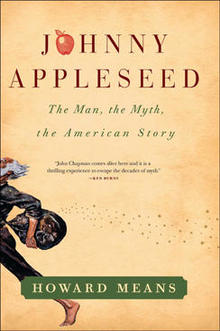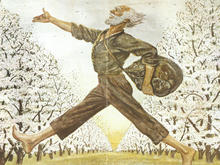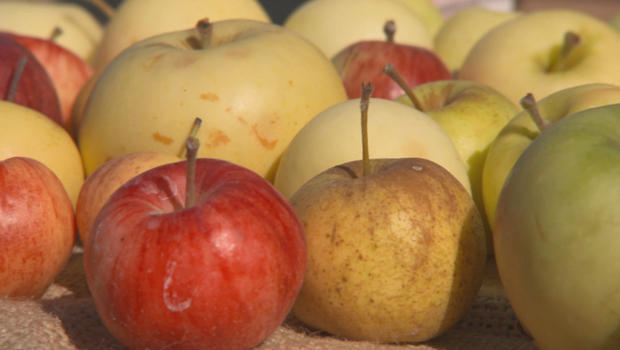AN APPLE A DAY may or may not keep the doctor away, but it’s a sentiment shared by just about everyone our Mo Rocca has been visiting:
At the Johnny Appleseed Festival in Fort Wayne, Ind., there’s no such thing as a bad apple. There you can indulge in apple dumplings — a skinless apple wrapped in dough, and deep-fried.
Rocca asked, “How healthy is this?
“Very healthy — it’s an apple!” he was told
Or partake of apple petals (“Better than apple dumplings!” enthused cutthroat vendor Logan Forbing), and sample some apple sausages.
Fort Wayne is where John Chapman — better known as Johnny Appleseed — died more than 170 years ago. Johnny is buried here — at least, the locals like to think so. According to author Howard Means (who wrote a book about the real Johnny Appleseed), “It’s very questionable it’s in fact the grave of John Chapman.”
Turns out there is much that’s misunderstood about the man many of us came to know through the 1948 Walt Disney cartoon.

Simon & Schuster
True or false: Johnny Appleseed was a simpleton with a tin pot hat who sprinkled seeds on the American frontier so that pioneer kids would have healthy snacks?
“The hat’s pretty accurate; the rest I’d have to say is false,” said Means. “He was not a simpleton at all, no. He’s a very complicated man with a very intense and deep spiritual life.”
The real Johnny Appleseed was a barefoot ascetic who was at one with nature … a man, Means wrote, “who seems to be almost independent of corporeal wants and sufferings. He goes barefoot, he can sleep anywhere, in house or out of house, and live upon the coarsest and most scanty fare.”
There are, alas, no accounts of his singing.
“That’s a bummer,” Rocca said. “That part’s really nice in the Disney cartoon!”
[embedded content]
But Johnny did sell lots of apple trees, from Pennsylvania to Indiana. “He started nurseries at the edge of the frontier — actually started them before civilization got there,” said Means.
“The land companies would sell you, say, 100 acres on the condition that you planted an orchard. And so you had a guy sitting there, waiting to sell you these seedlings.”
The fruits borne by those seedlings, though, weren’t exactly appetizing — and those apples weren’t for eating. They were used for hard cider. Yes, alcohol.

An illustration from the Saturday Evening Post showing American folk hero Johnny Appleseed.
Mike Munden/AP
“There was a lot of alcohol drunk on the frontier because it was a safe drink,” Means said. “Pure water was impossible to find for the most part.”
So, Johnny was pushing more than West.
At the Goeglein Mill in Fort Wayne, the the alcoholic apple juice is flowing. Don Goeglein’s grandfather started his cider press in 1929.
During Prohibition? “It was,” Goeglein said. “I told these guys when they started the hard cider business, they said, ‘Here’s the first taste.’ And I said, ‘Well, that’s not the first — that’s the first legal batch to come out!'”
In fact, it was the prohibition of alcohol that made the apple respectable.
“The apple-a-day for health was an effort by apple growers, after Prohibition came along, to find a new use for their product,” Means said.
There’s so much we don’t know about this most American fruit. For example, apples originated not in this country, but in the central Asian region of Kazakhstan. That’s from where the gene of the Golden Delicious variety came.

How’s them apples?
CBS News
Phil Forsline has been called the modern Johnny Appleseed. In the 1990s, as curator of the U.S. Department of Agriculture’s apple collection, Forsline went to Kazakhstan, where he found whole forests of wild apples.
“In one of the forests were trees that were probably 45 feet tall and some of the trunks were about three feet in diameter,” he said.
He and his team collected over 150,000 seeds … and grew a forest of their own in Geneva, New York.
Most of the apples here are spitters, either too dried out (“It’s a little like sawdust,” Rocca offered) or astringent. But a very few are downright tasty. And all of them together may prove invaluable to the survival of the apple.
Rocca asked, “Why was it important to bring all these seeds back?”
“Well, the gene pool that breeders were using prior to our going to Kazakhstan was very narrow,” Forsline replied.
Not much wider than a few commercially popular varieties, like the Red Delicious, the Golden Delicious, and the Macintosh. “We expanded the gene pool,” Forsline said. “We now have genes that can contribute some significant disease resistance to our apples, so we can probably eventually grow our apples with fewer pesticides.”
Which will make for healthier apples — old favorites, and new kinds, like the highly anticipated one being developed in Washington State. Grower Scott McDougall is betting the orchard that the Cosmic Crisp will be the new “It” apple when it rolls out in 2019.
“There’s so much excitement over it that, literally, there will be 12 million to 13 million trees planted within the next three to four years,” he said.
With its sparkling, rosy cheeks, the Cosmic Crisp is pomological royalty, descended from the beloved Honey Crisp, and the result of more than 20 years of breeding at Washington State University’s Tree Fruit Research Center, where scientists test for firmness, juiciness, and taste.
It’s anyone’s guess what Johnny Appleseed would think of the Cosmic Crisp. But one thing seems likely: he would have liked Fort Wayne’s Johnny Appleseed Festival!
“I didn’t,” said author Howard Means. “I couldn’t sell books there to save my life!”
For more info:
- Johnny Appleseed Festival, Fort Wayne, Ind.
- “Johnny Appleseed: The Man, the Myth, and the American Story” by Howard Means (Simon & Schuster), in Trade Paperback and eBook Formats; available via Amazon
- Goeglein Mill, Kekionga Cider Company, Fort Wayne, Ind.
- U.S. Department of Agriculture: Apples
- USDA Plant Genetic Resources Research, Geneva, N.Y.
- McDougall & Sons, Wenatchee, Wash
- Tree Fruit Research & Extension Center, Washington State University

